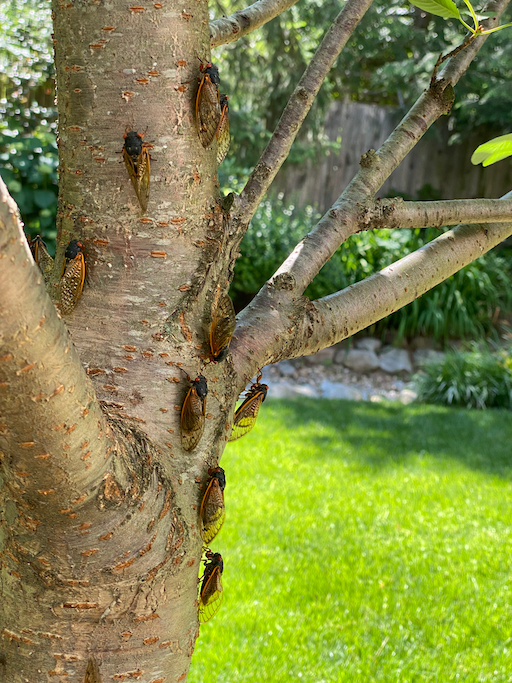Cicadas or "semi" 蝉 are very common in Japan. When I was growing up, my brother and I collected cicada nymphs when they emerged from the ground and started climbing the trees in the early evening. We brought them inside and let them spend the night clinging to the curtains in our bedroom. (Yes my mother was a saint). They would molt during the night and by the time we woke up the next morning, they were all dry and ready to fly. It was this transformation that fascinated us. After observing them for some time we just let them go. The cicadas of my childhood came out every year. They had brown eyes and opaque brown wings and were called "aburazemi" 油蝉 or "Large brown cicada". They spent about 3 years under ground but their emergence was not synchronized. So every year, a batch of about the same number would appear.
We took several pictures to commemorate the event. The first picture gives a glimpse of how they come out in droves. This is just a small segment of the continuous stream of cicada working their way up the tree from the ground. Looks almost like a cicada rush hour traffic jam up our small cherry tree which we planted about 3 years ago after our 30 some year old cherry tree was destroyed during nor easter.
Apparently pets (especially dogs) and wild animals (rats. mice, squirrels and birds) enjoy this bounty which for them is food. We watched a resident squirrel grab a cicada, rip off its wings, head and eat the rest all within seconds. Then eventually the squirrels became satiated. There were just too many cicada for them to eat so, in typical squirrel fashion, they started burying them. (Not sure how that helped. We pointed out to the squirrel that the next generation cicada in larva form would eventually end up underground again so burying the parent that was going to die anyway would not be helpful). Ok the recipes we saw in the media during this event were interesting in a certain intellectual sense but we were certainly not into it. We decided to leave the cicadas to the other gourmets such as the squirrels. Although this emergence of Brood X cicadas looked somewhat smaller and not as noisy or numerous than as the one 17 years ago, it was still one of the best floor shows put on by nature.




















































